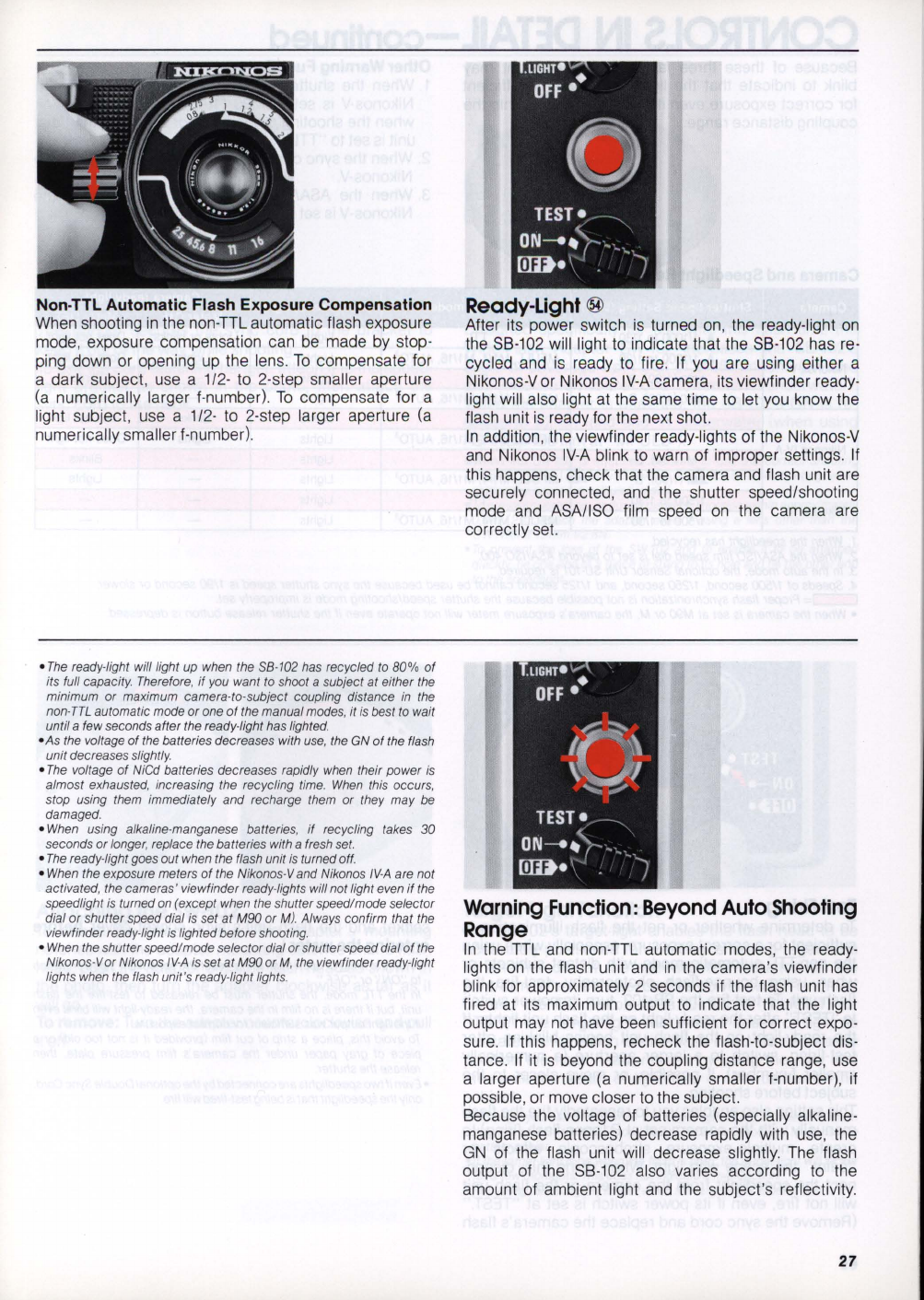
Non·TTL Automatic Flash Exposure Compensation
When shooting
in
the non-TTL automatic flash exposure
mode, exposure compensation can be made
by
stop-
ping down or opening
up
the lens.
To
compensate for
a dark subject, use a
1/
2-
to 2-step smaller aperture
(a
numerically larger f-number).
To
compensate for a
light subject, use a 1/2- to 2-step larger aperture
(a
numerically smaller f-number).
•
The
ready-light will light up when the S8-102 has recycled
to
80%
of
its full capacity. Therefore,
if
you want to shoot a subject at either the
minimum
or
maximum camera-to-subject coupling distance
in
the
non-
TTL
automatic mode
or
one
of
the manual modes, it is best to wait
until
a few seconds after the ready-light has lighted.
o
As
the voltage
of
the batteries decreases with use, the GN
of
the flash
unit decreases slightly.
o
The
voltage
of
NiCd batteries decreases rapidly when their power is
almost exhausted, increasing the recycling time.
When
this occurs,
stop using them immediately and recharge them or they may be
damaged.
o When using alkaline-manganese batteries,
if
recycling takes 30
seconds
or
longer, replace the batteries with a fresh
set.
o
The
ready-light goes out when the flash unit
is
turned off.
o When the exposure meters
of
the Nikonos-Vand Nikonos IV-A are not
activated, the cameras' viewfinder ready-lights will not light even
if the
speedlight is turned
on
(except when the shutter speed/mode selector
dial
or
shutter speed dial is set
at
M90
or
M)
. Always confirm that the
viewfinder ready-light is lighted before shooting.
o When the shutter speed/mode selector dial
or
shutter speed dial
of
the
Nikonos-Vor Nikonos IV-A is set at M90 or M, the viewfinder ready-light
lights when the flash unit's ready-light lights.
Ready-
Light
®
After its power switch
is
turned
on,
the ready-light
on
the 8B
-102
will light to indicate that the 8B
-102
has
re
-
cycled
and
is
ready to fire. If
you
are using either a
Nikonos-V or Nikonos I
V-
A camera, its viewfinder
rea
d
y-
light will also light
at
the same time to let
you
know the
flash unit
is
ready for the next shot.
In
addition, the viewfinder ready-lights of the Niko
no
s-V
and
Nikonos
IV-A
blink to warn of improper settings. If
this happens, check that the camera
and
flash unit are
securely connected,
and
the shutter speed/shooting
mode and A8A/180 film speed
on
the camera are
correctly set.
Warning
Function:
Beyond
Auto
Shooting
Range
In
the TTL
and
non
-
TT
L automatic modes, the ready-
lights
on
the flash unit
and
in
the camera's viewfinder
blink for approximately 2 seconds if the flash
un
it has
fired
at
its
maximum output to indicate that the light
output may not have been sufficient for correct expo-
sure. If this happens, recheck the flash-to-
su
bject
di
s-
tance. If
it
is
beyond the coupling distance range,
use
a larger aperture
(a
numerically smaller f-number), if
possible, or move closer to the subject.
Because the voltage of batteries (especially alkaline-
manganese batteries) decrease rapidly with
use
, the
GN
of the flash unit will decrease slightly. T
he
flash
output of the 8B-
102
also varies according to the
amount of ambient light
and
the subject's reflectivity.
27


















